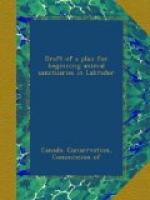10. These islands are favourite haunts of the American eider ("sea-duck”, “metik”, Somateria dresseri.)
Perhaps the Northern or Greenland eider (Somateria mollissima borealis) might also be induced to concentrate there. There seems to be no reason why an eider-down industry should not be built up by the end of the five years. The eider ought to be specially protected all the way up to the Pilgrims, which are only 100 miles below Quebec. The Province might do this from Natashquan west.
11. Begin by protecting all birds except the Great Blackback Gull ("Saddleback”, Larus marinus) which is very destructive to other bird life. Let its eggs and young be taken at all times; but prevent adult birds from being shot before the 1st of September, so as not to starve the helpless young to death. When other species become really noxious it will be time enough to treat them in the same way. As a rule, the harm done by birds popularly but falsely supposed to live on food fishes, and by birds of prey, is grossly exaggerated. Birds and beasts of prey often do good service in keeping up a breed by killing off the weaklings.
12. It would be well worth while to keep the Inspector on for the eight months between the 1st of September, 1913, and the 1st of May, 1914, so that he and the Provincial warden might make a thorough investigation of conditions all the year round, inland as well as on the coast, and of the mammals as well as of the birds. One man from each of the five local boats and two men from the Inspector’s boat would make seven assistants already trained in conservation. They would have to be paid enough to counterbalance their strong desire for the rare but sometimes relatively enormous profits of “furring”. Perhaps $50 a man a month would do, the men to find themselves in everything, as during the summer. This, for seven men for eight months, would be $2,800. The incidental expenses and Inspector’s salary would bring the total up to $5,000. The Inspector cannot be too good a man. He should be a good leader as well as a trained naturalist. The Province should send him the best warden it can find, to act as his chief assistant. After a year’s work, afloat and ashore, in summer and winter, with birds and mammals, he ought to be able to make a comprehensive and unbiassed report, which, by itself, would repay the Commission for introducing conservation into such a suitable area. Zoogeographic maps and charts would be an indispensable part of this report.
* * * * *
To sum up:—
I beg to propose that the Commission should bring the Canadian Labrador under conservation by protecting bird life on the coast for a term of five years, as an experimental investigation, and by examining, for one year, the whole question of the birds and mammals, inland as well as on the seabord, and in winter as well as summer. The cost of the first would be $5,000 a year for five years = $25,000. The cost of the second would be $5,000 for one year only. The total cost would be $30,000.




